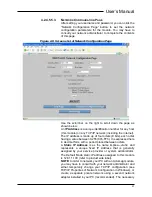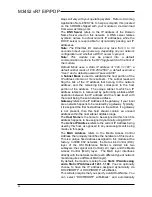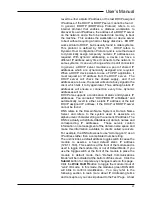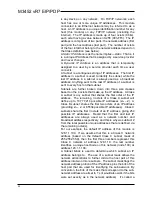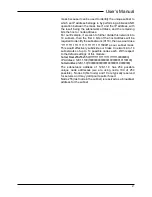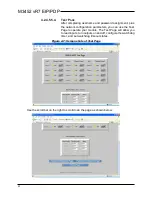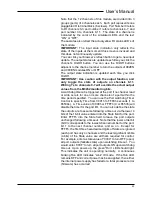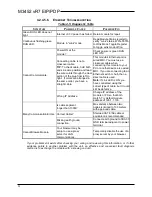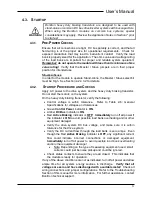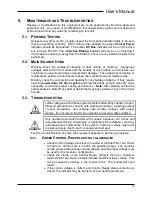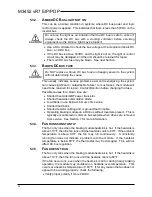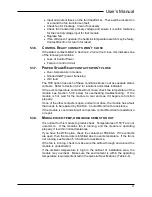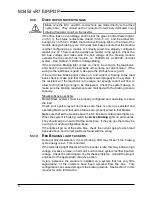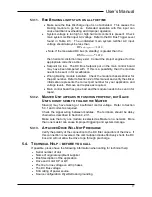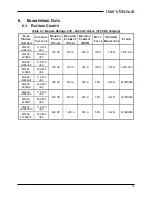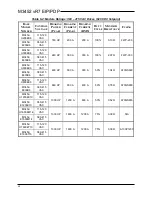
User’s Manual
45
revert to either a static IP address, or the last DHCP assigned
IP address, if the DHCP or BOOTP server cannot be found.
In general, BOOTP (BOOTstrap Protocol) refers to an
internet protocol that enables a diskless workstation to
discover its own IP address, the address of a BOOTP server
on the network, and a file to be loaded into memory to boot
the machine. This enables the workstation or device server
to boot without requiring a hard or floppy disk drive. BOOTP
works similar to DHCP, but is usually found in older systems.
This protocol is defined by RFC 951. DHCP refers to
Dynamic Host Configuration Protocol and is a method used
to dynamically assign temporary numeric IP addresses as
required. With dynamic addressing, a device can have a
different IP address every time it connects to the network. In
some systems, it can even change while it is still connected.
In general, a DHCP server maintains a pool of shared IP
addresses which are dynamically assigned and recycled.
When a DHCP device wants to use a TCP/IP application, it
must request an IP address from the DHCP server. The
DHCP server will check the shared supply, and if all
addresses are in use, the server will send a busy signal to the
client which tells it to try again later. Thus, although static IP
addresses will ensure a connection every time, dynamic
addresses will not.
DHCP also supports a combination of static and dynamic IP
addresses.
You can select “DHCP/BOOTP w/Fallback” and
automatically revert to either a static IP address, or the last
DHCP assigned IP address, if the DHCP or BOOTP server
cannot be found.
DNS refers to the Domain Name System or Domain Name
Server and refers to the system used to associate an
alphanumeric character string with a numeric IP address. The
DNS is actually a distributed database of domain names and
corresponding IP addresses. These servers contain
information on some segment of the domain name space and
make this information available to clients called
resolvers
.
For example, the DNS allows us to use “Acromag.com” as an
IP address rather than a complicated number string.
The unit includes a default address toggle switch to cause the
module to assume a fixed default static IP address
(128.1.1.100). This switch is at the front of the module and is
used to toggle the module into, or out of Default Mode. If you
use the toggle switch at the front of the module to place the
module in default mode, then “Default Communications
Mode” will be indicated at the bottom of this screen. Click the
Submit
button to complete any changes made on this page.
Click the
Wink On/Off
button to toggle the module in/out of
“wink” ID mode. In this mode, the module’s green RUN LED
will blink to confirm identification. You may refer to the
following section to learn more about IP Addressing terms
and concepts, or you can skip ahead to the Test Page. A host
Summary of Contents for M3452
Page 14: ...M3452 vR7 EIP PDP 14 This page intentionally left blank ...
Page 19: ...User s Manual 19 Figure 3 2 Customer Connections in K9 Chassis CUSTOMER I 0 CONNECTION ...
Page 21: ...User s Manual 21 Figure 3 2 Customer Connections in M14 Chassis CUSTOMER I O CONNECTION ...
Page 24: ...M3452 vR7 EIP PDP 24 Figure 3 6 I O Hookup with R7 EIP PDP Communication ...
Page 26: ...M3452 vR7 EIP PDP 26 Figure 3 8 24VDC Power Connection ...
Page 58: ...M3452 vR7 EIP PDP 58 This page intentionally left blank ...
Page 66: ...M3452 vR7 EIP PDP 66 Figure 6 3 M3452 K9 Chassis Dimensional Outline Drawing ...
Page 68: ...M3452 vR7 EIP PDP 68 Figure 6 5 M3452 M14 Chassis Dimensional Outline Drawing ...
Page 75: ...User s Manual 75 NOTES ...
Page 76: ...M3452 vR7 EIP PDP 76 This page intentionally left blank ...
Page 77: ......
Page 78: ......
Page 79: ......













